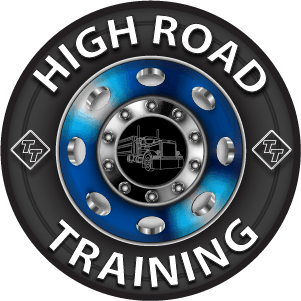Applied Pressure Or Stab Breaking?
Topic 10586 | Page 1

Maybe a bit of confusion here. Stab braking is for emergency braking. With stab braking you're hitting 'em hard enough to lock up the brakes, then release. Controlled braking is when you use enough pressure to slow down but you're not locking up the brakes intentionally. I'm assuming you meant 'controlled braking.'
The latest research supports controlled braking. You're supposed to use it in context of the 5-3 method. For other readers, 5-3 is when you determine your safe speed, brake with enough pressure where you're only applying constant pressure for 3 seconds to bring you 5 mph below your safe speed. Wait for your truck to reach that safe speed again, rinse and repeat the 5-3 method. That's controlled braking.
Some old timers still use constant pressure and swear by it. Schools are teaching the 5-3 with controlled braking for a reason, but, some drivers can brake safely with the constant pressure method. I'd be careful teaching a new driver the constant pressure method, since they might over-brake and not know how much pressure to use. Controlled braking using the 5-3 technique seems to me that it would protect a new driver from smoking the brakes.

Personally I have only used stab breaking in panic stops. Otherwise I go for the smooth ride.
Phil
I'm not kidding - we had that exact conversation when I was in truck driving school in 1993. Still to this day you'll find people on both sides of the aisle that will say you can only do it their way and you'll get killed if you do it the other.
The most interesting theory I heard was that if done properly both methods put about the same amount of total heat into the brakes and allow them to cool at about the same rate. Both techniques are used daily all over the country and work just fine. The key, of course, is the speed you're going. If you're going slowly enough in the proper gear then both techniques can work just fine.

Maybe a bit of confusion here. Stab braking is for emergency braking. With stab braking you're hitting 'em hard enough to lock up the brakes, then release. Controlled braking is when you use enough pressure to slow down but you're not locking up the brakes intentionally. I'm assuming you meant 'controlled braking.'
The latest research supports controlled braking. You're supposed to use it in context of the 5-3 method. For other readers, 5-3 is when you determine your safe speed, brake with enough pressure where you're only applying constant pressure for 3 seconds to bring you 5 mph below your safe speed. Wait for your truck to reach that safe speed again, rinse and repeat the 5-3 method. That's controlled braking.
Some old timers still use constant pressure and swear by it. Schools are teaching the 5-3 with controlled braking for a reason, but, some drivers can brake safely with the constant pressure method. I'd be careful teaching a new driver the constant pressure method, since they might over-brake and not know how much pressure to use. Controlled braking using the 5-3 technique seems to me that it would protect a new driver from smoking the brakes.
Hudsonhawk's trainer pontificates:
One told me never to stab brake because it causes heat and friction on the brakes much too quickly.
That's what brakes are made for!!!! Brakes take up the motion energy (slowing you down a bit) and turn it into heat that can radiate away.
6 string straightens out the terms:
The latest research supports controlled braking. ... you determine your safe speed, brake with enough pressure where you're only applying constant pressure for 3 seconds to bring you 5 mph below your safe speed. Wait for your truck to reach that safe speed again, rinse and repeat the 5-3 method. That's controlled braking.
The on again off again method helps take the heat generated and gives it time to move through both the brake pads and the brake drum. Understanding this is Middle School Science*, and it makes your brakes last longer during this downhill run.
Steady state braking will not allow the heat to radiate away fast enough. Then they don't work at all. This is brake failure way more than running out of air pressure would be.
*I oughtta know, I'm the resident Trucking Truth Science and Math teacher.
OWI:
Operating While Intoxicated
It's funny how many different ways you'll hear veteran drivers advise newbies to brake. My trainer tried to teach me to only use the trolley valve, or just the trailer brakes when descending a mountain. His reason was that when your brakes catch on fire, then you still have the tractor brakes to help you get stopped!
And sure enough he caught the trailer on to such a fire that we had to get a fire truck out to put it out.
I mostly ignored my trainer when I knew better. He learned a lot from me, especially concerning HOS , and how to manage his clock. That was the one thing that thirteen year veteran thanked me for... he never knew eight hours on the sleeper berth line would extend your clock.
Sleeper Berth:
The portion of the tractor behind the seats which acts as the "living space" for the driver. It generally contains a bed (or bunk beds), cabinets, lights, temperature control knobs, and 12 volt plugs for power.
HOS:
Hours Of Service
HOS refers to the logbook hours of service regulations.
Thanks for the information
My trainer tried to teach me to only use the trolley valve, or just the trailer brakes when descending a mountain. His reason was that when your brakes catch on fire, then you still have the tractor brakes to help you get stopped!
And sure enough he caught the trailer on to such a fire that we had to get a fire truck out to put it out.
Appalling. That's just embarrassingly poor knowledge. How long had that guy been driving?
I know this doesn't apply to your trainer, but the old timers were often owner operators and they used to use the trolley valve in order to save the brakes on their tractor, which they had to pay for of course.
Owner Operator:
An owner-operator is a driver who either owns or leases the truck they are driving. A self-employed driver.
New Reply:
New! Check out our help videos for a better understanding of our forum features

















Preview:








 TT On Facebook
TT On Facebook
So I've had two trainers so far tell me two different methods of braking.
One told me never to stab brake because it causes heat and friction on the brakes much too quickly. And he also mentioned that if you have a team that your team partner might be in the back using a Gatorade bottle to urinate. So to take it easy and do applied Pressure braking in combination with the engine brake. He said that if you lightly hit the brakes until it just catches then let up a little the friction is less and it causes less friction and heat transfer. Said to never do this above the first mark on the air application gauge and if you hear the air brakes discharging that you hit it too much. This guy had about 20+ years experience.
The other instructor said to use only stab braking unless weather conditions don't permit it or your load is at risk for shifting. Said that applied Pressure just heats the pads up too quickly and that it can cause brake failure. This guy had about 2 years experience.
Now I know if your in a low enough gear with an engine brake you can usually hit a downhill with minimal brake usage which is what I've done mostly. I've done both kinds of braking and don't see the stab braking as being safe really. When your moving down hill. At the same time I haven't seen the applied Pressure react quick enough sometimes.
Does anyone have any advice? I'm just looking for any other input that someone may have in this matter.